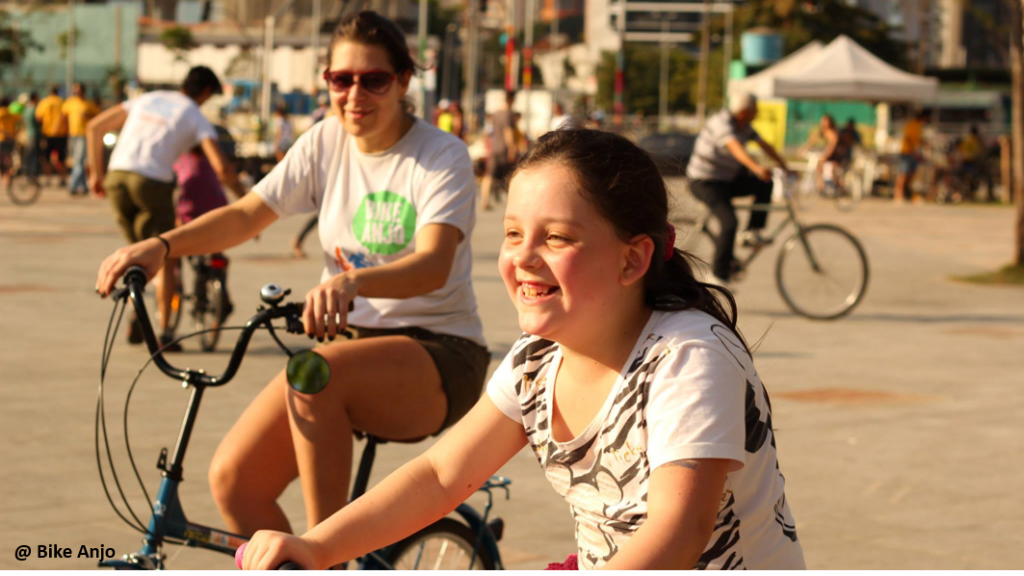
1. Presentation
Implementation of education programmes for current and potential bicycle users, which promote and capacitate for cycling, providing skills that help them to overcome some of the key issues affecting cyclists’ safety: vulnerability, instability, invisibility and inconsistent skills.
2. Objectives
- Promoting safe cycling, through knowledge and adoption of appropriate behaviours;
- Reducing the risk of incidents and injuries;
- Promoting harmonious coexistence between the various users of the public road.
3. Measure’s Importance
In starter cycling cities, one of the main barriers to cycling is not feeling safe to ride a bicycle in the city, and it is critical to make current and potential users safe and confident. The safety of the cyclist stems from the existence of adequate infrastructure and an environment designed for people, but also from the responsibility of the cyclist himself, especially in starter cities where infrastructure and bicycle awareness are limited.
1. Good Practices
– Start with the target groups identified as priority.
– Actions should focus on promoting safe behaviour and not create additional barriers that discourage cycling.
– They should be developed in collaborative environments and dynamic formats that encourage everyone’s active involvement and focus on the fun and social component of cycling.
– To be effective, a commitment is required to deliver this type of programme on a regular and long-term basis.
– Trainers/ educators for cycling mobility should be adequately trained, including awareness of different types of limitation (not just physical) and discrimination.
– Education for cycling mobility should be a way of promoting and educating citizenship by promoting positive and responsible behaviours.
– Monitor citizens’ adaptation to changes and reformulate measures to respond to users’ needs, without compromising sustainable ideals (See Management, monitoring and maintenance).
– Explain the principles behind the measures taken so that their need and functioning are clear (See Information).
2. Actions
 | Education/ training programmes Education for different content that makes cycling safer, including: • Bicycle maintenance and repair, ensuring proper safety conditions; • Route planning guidance; • Traffic rules, road citizenship and familiarity with different traffic situations; • Safety of the environment surrounding the cyclist; • Other content depending on the target group. |
 | Guidelines and rules for cycling mobility The establishment of rules on cyclist behaviour in traffic is important as a safety guidance. However, the enforcement of regulations should be made with caution, in order not to raise additional barriers to cycling. For instance, although cyclists should ride on the road rather than on sidewalks, strict enforcement of a no-cycling-on-sidewalks rule will effectively prohibit cycling by some types of users (children and inexperienced cyclists); likewise, mandatory helmet creates an additional barrier to the potential cyclist and does not directly contribute to making the environment safer for cycling. Learn more: Road Safety and the importance of active mobility in European cities Bike Riders and sharing the road (Australia). |
 | Bicycle Co-labs Collaborative labs are a dynamic way to share information and to collectively build and experiment new bike solutions, tailored to each specific context. They are a way of involving different audiences in the education and co-construction of cycling mobility. Learn more: Bycs Co-labs |
 | Promotion of cycling groups Bicycle-related tours, meetings and other group experiences are particularly important due to their social component and positive impacts on safety. Learn more: Belles on Bikes (UK) - programme to support women to get cycling together in a friendly and relaxed environment, with various groups across Scotland. Hoy me toca a mi (Basque Country) - programme to promote women's cycling through learning courses and cycling tours. |
 | Actions for theft and harassment prevention Scheme of prevention against theft carried out by the municipal police, including voluntary bicycle registration, guidance on measures against theft, campaigns against harassment (specially against female cyclists) and mapping of cycling incidents and theft locations, which may increase the perception of safety and cycling attractiveness for all, and allowing to identify recovered bicycles. Learn more: Bikemaps (USA) – site for mapping cycling incidents, hazard, and theft locations so they can be analysed to identify hot spots of cycling safety, risk, and crime. |
 | Cycling classes (See Cycling classes) |
1. Impacts
 | Mobility system efficiency Cycling mobility education contributes to the safety of the overall transport network, reducing accident rates and increasing cycling modal share, thus promoting less congestion and increasing efficiency of the mobility network. |
 | Livable streets Increased levels of cycle safety mean streets are safer, more accessible and more comfortable for all users (including those travelling by car, foot or public transport). Safer environments bring more people into the cities’ streets, promoting more livable streets. |
 | Protection of the environment The local environment is improved by the promotion of cycling. |
 | Inclusion, equity and accessibility Provision of cycling mobility education makes cycling more safe and accessible to all, reaching more destinations, also becoming more attractive to those who cannot afford or do not want to buy a car, to women, children and teenagers, elders and to those with disabilities, thus promoting social equity. |
 | Safety and comfort These measures are at the cornerstone of cycle safety, promoting a behaviour change of various users (drivers, cyclists, pedestrians) and contributing directly to the reduction of accidents and injuries. However, this cannot be achieved by education programmes alone; it is critical that infrastructure and policy support cycling and provide a safe environment for cycling. |
 | Economic value There is evidence that enhanced cycle safety and increased cycling can improve and revitalize the economy of city centres. |
 | Awareness and acceptability Cycling mobility education, focused on the different target-groups, is essential to raising awareness and breaking resistance to cycling, as it promotes a bicycle-friendly environment and people become more informed and develop the abilities required to cycle safely. |
Legend:
| Very positive | Positive | Neutral | Negative | Very negative |
2. Barriers
 | Legal There are no legal barriers to the provision of cycling mobility education. Ultimately, this will lead to a shift in the dominant mobility paradigm demanding structural reallocation of infrastructures and changes to traffic regulations and the overall legal framework. |
 | Finance The implementation of most of the measures is relatively inexpensive; however, most of them should be carried out on a continuous basis, requiring constant funding. |
 | Governance Responsibility usually rests with one authority and/or schools in the case of programmes targeting schools, though collaboration with the police may be needed, and eventually cycling associations and other interest groups. Some strategies require police, planners and citizens to consider new approaches and implement new types of programmes. |
 | Political acceptability Safety and danger reduction improvements usually receive broad political support. However, the fact that only a small part of the population commutes by bicycle (0.5% in Portugal) removes its electoral and claiming power. |
 | Public acceptability It is expected that a range of groups will support these measures, especially pro-cycling movements; however, there are lobbies that might oppose, particularly car users and the car cluster. |
 | Technical feasibility Cycle safety education programmes do not offer technical barriers. |
Legend:
| No barrier | Minimum barrier | Moderate barrier | Significant barrier |
3. Budget
| Area | Measure | Unit | Cost | Implementation year |
| U.K. | Bike distribution programme (3000 free and 1000 borrowed), as well as additional equipment, cycling training programmes, maintenance and guided tours | 2 financial years | 0,24 million £ | Data from 2017 study |
| Seville, Andalusia (Spain) | “Centro Educación Vial” (includes activities, website, books and notebooks for children and their educators to inform how to travel safely in the public space) | 4 years | 304 000,00 € | 2007 |
Case study 1: Safe routes: National Centre for Safe Routes to School (USA)

The National Centre for Safe Routes to School, established in 2006, promotes safe walking and biking, providing ways for communities to get started and offering the quality and updated information. It uses research-based evidence to highlight what works and why, translating research into education, professional development tools and training to provide communities the technical support they need. Among its actions are: “Bike to School Day” to encourage families to celebrate the benefits of biking and to increase local leader commitment and visibility for traffic safety and community quality of life; “Vision Zero for Youth” initiative, aiming to eliminate traffic fatalities and serious injuries, particularly by focusing on improving safe walking and bicycling and slowing traffic speeds in zone where children and youth are present; “Safe Routes to School” aiming to make it safer for students to walk and bike to school, by developing resources, providing technical assistance, and conducting marketing campaigns.
Learn more: www.saferoutesinfo.org; www.pedbikeinfo.org; http://visionzeroforyouth.org
Impact:
 | Mobility system efficiency The promotion of safe routes to school encourages cycling by starting with youth who also can be the spark that creates broader community support. The programme’s results show promising upward trend in the percentage of students walking and cycling to and from school, promoting the reduction of road congestion. |
 | Livable streets By starting with children and trips to school, communities become safe places for everyone to walk and bike, bringing more people into the streets. |
 | Protection of the environment The local environment will necessarily be improved (though there is no specific data available). |
 | Inclusion, equity and accessibility Creating places for walking and cycling enhances the entire community’s quality of life, thus promoting social equity. Furthermore, in 2015, the National Centre’s analysis found that low-income communities were well represented in the Programme’s funding. |
 | Safety and comfort By reducing danger for everyone in public roads, communities take a major step towards meeting the national goal of ending traffic deaths on roads. |
 | Economic value No specific data on this topic, but it is expected that the programme encourages different economic initiatives around bicycle. |
 | Awareness and acceptability The programme brings elected officials and community members together to commit to improving safety for all, while focusing primarily on children and youth who can be the spark for raising a broader awareness and breaking resistance to cycling. |
Case study 2: Bike Anjo (Brazil)

Bike Anjo is a network of cyclists that promotes, mobilizes and helps people to start cycling in cities. It was created in the city of São Paulo and spread to various cities in Brazil and around the world (such as the “Bike Buddy” programme of Mubi -Association for Urban Mobility by Bicycle, in Portugal). The network runs on a collaborative basis through an online platform where those interested can find help from volunteers to learn how to ride a bike, escort in traffic, recommendations for routes, safety tips, etc. It also promotes various events and campaigns. It is funded through crowdsourcing campaigns and by public or private sponsors.
Learn more: bikeanjo.org; bikebuddy.mubi.pt
Impact:
 | Mobility system efficiency The growing number of people registered on the platform (currently covering 708 cities and 34 countries) indicates a possible increase in the bicycle modal split and the number of cyclists aware of traffic safety, which could have an impact either in reducing the number of cars and in reducing the number of traffic accidents. |
 | Livable streets Bike Anjo promotes various initiatives of occupying the streets and public space of cities and, thus, it contributes to more friendly and livable streets. |
 | Protection of the environment There is no specific information on the modal shift achieved by the project, nor the mitigating effects on CO2 and other pollutants; however, by helping to increase cycling as a mode of transport, the local environment will necessarily be improved. |
 | Inclusion, equity and accessibility The programme voluntarily and free of charge and seeks to meet the needs of different groups, including actions in the cities’ peripheries, hence contributing to greater social equity. |
 | Safety and comfort By promoting learning to ride and traffic orientation actions the programme contributes directly to more safety and comfort in traffic. |
 | Economic value No specific data on this topic, but it is expected that the programme encourages different economic initiatives around cycling. |
 | Awareness and acceptability The programme brings citizens together to work voluntarily and collaboratively in order to promote cycling and improve safety of all, contributing to greater awareness and to breaking down resistance to bicycle. |
Legend:
| Very positive | Positive | Neutral | Negative | Very negative |
ANSR – Autoridade Nacional de Segurança Rodoviária (2014). Guia do Condutor de Velocípede. Accessed 13 January 2019. Available at: http://www.ansr.pt/SegurancaRodoviaria/Publicacoes/Documents/GUIA%20CONDUTOR%20VELOC%C3%8DPEDE.pdf
Baker, L. (2009). How to Get More Bicyclists on the Road: To boost urban bicycling, figure out what women want. Scientific American, pp. 28–29. Accessed 2 July 2019. Available at: https://www.scientificamerican.com/article/getting-more-bicyclists-on-the-road/
KonSULT. Knowledgebase on Sustainable Urban Land use and Transport. (2014). Cycle & Pedestrian Safety. Accessed 2 July 2019. Available at: http://www.konsult.leeds.ac.uk/pg/65/
European Union (2019). Road Safety Observatory. Accessed 2 July 2019. Available at: https://ec.europa.eu/transport/road_safety/specialist/observatory_en
IMPIC. Base: Contratos públicos online. Accessed 2 July 2019. Available at: http://www.base.gov.pt/Base/pt
OECD (2004). Keeping Children Safe in Traffic. Paris: OECD Publishing. Accessed 13 January 2019. Available at: https://doi.org/10.1787/9789264106314-en
Pucher, J., & Dijkstra, L. (2000). Making Walking and Cycling Safer: Lessons from Europe. Transportation Quarterly, 54(3), 25–50. Disponível em: https://doi.org/10.1258/0007142001903184
ROSE25 (2005). Inventory and compiling of a European good practice guide on road safety education targeted at young people (Final report). KfV, Vienna.
ROSPA. Royal Society for the Prevention of Accidents. (2017). Sharing the Road Together: Drivers and Cyclists. Birmingham: Royal Society for the Prevention of Accidents. Accessed 22 February 2019. Available at: www.rospa.com/road-safety/advice/pedal-cyclists/sharing-the-road-together-drivers-cyclists/
Savan, B., Cohlmeyer, E., & Ledsham, T. (2017). Integrated strategies to accelerate the adoption of cycling for transportation. Transportation Research Part F: Traffic Psychology and Behaviour, 46, 236–249. Accessed 13 January 2019. Available at: https://doi.org/10.1016/j.trf.2017.03.002
Stredwick, A. (2017) Why don’t more women cycle? Accessed 2 July 2019. Available at: www.cyclinguk.org/article/campaigns-guide/women-cycling
Taylor, I. & Hiblin, B. (2017). Typical Costs of Cycling Interventions: Interim analysis of Cycle City Ambition schemes. Accessed 2 July 2019. Available at: http://www.transportforqualityoflife.com/policyresearch/cyclingandwalking/
Transport for London (2014). Cycle safety action plan. Accessed 13 January 2019. Available at: https://tfl.gov.uk/corporate/safety-and-security/road-safety/cycle-safety
VTPI. Victoria Transport Policy Institute (2018). Address security concerns: improving personal security for walking, cycling, transit and urban infill. Online Transportation Demand Management (TDM) Encyclopedia. Accessed 2 July 2019. Available at: http://www.vtpi.org/tdm/tdm37.htm
Wittink, R. (2001). Promotion of mobility and safety of vulnerable road users: final report of the European research project PROMISING (Promotion of Measures for Vulnerable Road Users). D-2001-3. Leidschendam: SWOV Institute for Road Safety Research. Accessed 13 January 2019. Available at: https://www.swov.nl/sites/default/files/publicaties/rapport/d-2001-03.pdf
ViC Roads (2019). Bike riders and sharing the road. Accessed 2 July 2019. Available at: www.vicroads.vic.gov.au/safety-and-road-rules/cyclist-safety/sharing-the-road.
